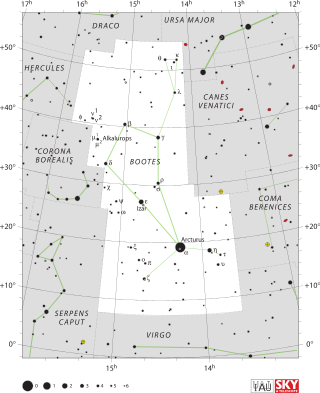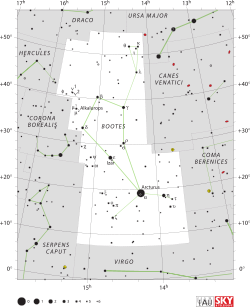Top Qs
Timeline
Chat
Perspective
Gamma Boötis
Binary star system in the constellation Boötes From Wikipedia, the free encyclopedia
Remove ads
Gamma Boötis is a binary star[12] system in the northern constellation of Boötes the herdsman, forming the left shoulder of this asterism.[13] Its name is a Bayer designation that is Latinised from γ Boötis, and abbreviated Gamma Boo or γ Boo. The primary component has the proper name Seginus, pronounced /sɪˈdʒaɪnəs/,[citation needed] the traditional name of the Gamma Bootis system.[14] It has a white hue and is visible to the naked eye with a typical apparent visual magnitude of +3.03.[2] Based on parallax measurements, it is located at a distance of 86 light-years, but is drifting closer to the Sun with a radial velocity of −32 km/s.[6]
Remove ads
Properties
Summarize
Perspective
The double nature of this system was discovered by American astronomer S. W. Burnham in 1878, and has the discovery code BU 616.[15] The system is resolved into a pair separated by 33.4 arcseconds with a brightness difference of 9.7 magnitudes. The brighter primary is itself a close pair separated by 0.069″,[16] as discovered by B. L. Morgan and associates in 1975.[15] The primary or 'A' component of this double star system is designated WDS J14321+3818 ('B' is the star UCAC2 45176266[17]) in the Washington Double Star Catalog. Parallax measurements for component B give a distance of approximately 1,879 light-years.[18] Gamma Boötis' two components are themselves designated WDS J14321+3818Aa (Seginus)[14] and Ab.

The stellar classification of Gamma Boötis is A7IV+(n),[2] matching an A-type star with somewhat "nebulous" lines due to rapid rotation. It was found to be a short-period variable star in 1914 by German astronomers P. Guthnick and R. Prager. Non-radial pulsations were detected in 1992 by Edward J. Kennelly and colleagues.[10] It is a Delta Scuti-type variable star with a period of 6.96753 h that varies from magnitude +3.02 down to +3.07.[3] This dominant mode is 21.28 cycles per day with an amplitude of 0.05 in magnitude.[10] Additional pulsations occur at 18.09, 12.02, 11.70 and 5.06 cycles per day.[4]
These types of stars are usually on the main sequence or slightly evolved.[4] The primary is around one billion years old with 2.1 times the mass of the Sun[7] and 4.65 times the Sun's radius.[20] Measurements of the projected rotational velocity range from 115 to 145 km/s,[4] suggesting a high rate of spin. On average, the star is radiating 33.4 times the luminosity of the Sun[9] from its photosphere at an effective temperature of 7,800 K.[10]
The system displays a statistically significant infrared excess due to a circumstellar disk. A model fit to the data indicates this material has a mean temperature of 85 K and is orbiting at a distance of 99±10 AU.[9]
Remove ads
Nomenclature
Summarize
Perspective
γ Boötis (Latinised to Gamma Boötis) is the binary's Bayer designation. WDS J14321+3818 is the wider system's designation in the Washington Double Star Catalog. The designations of the two constituents as WDS J14321+3818A and B, and those of A's components—WDS J14321+3818Aa and Ab—derive from the convention used by the Washington Multiplicity Catalog (WMC) for multiple star systems, and adopted by the International Astronomical Union (IAU).[21]
Gamma Boötis bore the traditional name Ceginus (later Seginus), from cheguius or theguius, apparently Latin mistranscriptions of an Arabic rendering of Greek Boötes.[22] Two possibilities have been suggested: from Arabic بوطس bwṭs, in one of the manuscripts of the Almagest, with undotted ب b mistaken for an undotted ث th, و w taken as w and spelled 'gu', and ط ṭ completely misread,[23] or from Arabic بؤوتس bwʾwts, with undotted ب b mistaken for an undotted ث th, ؤ w-hamza mistaken for غ ġ, و w read as u, and undotted ن n misread as an undotted ى y and transcribed i—that is, as th-g-u-i-s with unwritten vowels (and the Latin grammatical ending -us) filled in for theguius.[24]
In 2016, the IAU organized a Working Group on Star Names (WGSN)[25] to catalogue and standardize proper names for stars. The WGSN decided to attribute proper names to individual stars rather than entire multiple systems.[26] It approved the name Seginus for WDS J14321+3818Aa on 21 August 2016 and it is now so included in the List of IAU-approved Star Names.[14]
Gamma Boötis was listed as Haris in Bečvář, apparently derived from the Arabic name of the constellation of Boötes, Al-Haris Al-Sama meaning "the guard of the north".[22]
In the catalogue of stars in the Calendarium of Al Achsasi al Mouakket, this star was designated Menkib al Aoua al Aisr (منكب العواء الأيسر – mankibu lʿawwaaʾi lʾaysar), which was translated into Latin as Humerus Sinister Latratoris, meaning 'the left shoulder of barker'.[27]
In Chinese astronomy, Gamma Boötis is called 招搖, Pinyin: Zhāoyáo, meaning Twinkling Indicator, because this star is marking itself and standing alone in Twinkling Indicator asterism, Root mansion (see: Chinese constellation).[28] 招搖 (Zhāoyáo), westernized into Chaou Yaou, but the name Chaou Yaou was designated for Beta Boötis (Nekkar) by R.H. Allen and the meaning is "to beckon, excite, or move."[13]
Namesake
USS Seginus (AK-133) was a U.S. Navy Crater-class cargo ship named after the star.
Remove ads
References
External links
Wikiwand - on
Seamless Wikipedia browsing. On steroids.
Remove ads

